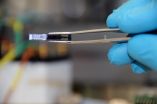Study links severe restless legs syndrome to increased risk of stroke
RLS can be considered a clinical marker or early risk factor of stroke, which has potential for modifications in clinical management
2015-06-08
(Press-News.org) DARIEN, IL - A new study suggests that increased restless legs syndrome (RLS) severity is associated with subsequent increased risk of stroke.
Results show that increased RLS severity is associated with subsequent increased risk of stroke, after considering other known risk factors such as age, smoking, hypertension, and unhealthy diet. There were 161 incident stroke cases during the six-year follow-up.
"We were surprised at the importance of taking into account RLS severity -- it was only severe RLS, not milder RLS, that was associated with increased risk of stroke," said principal investigator and senior author Xiang Gao, associate professor and Director, Nutritional Epidemiology Lab, department of Nutritional Sciences at The Pennsylvania State University in University Park, Pa.
The research abstract was published recently in an online supplement of the journal Sleep and will be presented Monday, June 8, in Seattle, Washington, at SLEEP 2015, the 29th annual meeting of the Associated Professional Sleep Societies LLC.
The study group comprised 72,916 female registered nurses ages 41-58 years in 2005, free of diabetes, stroke, and pregnancy at the baseline. Information on RLS was collected via a questionnaire which was based on International RLS Study Group criteria.
INFORMATION:
The study was supported with funding by the National Institutes of Health (NIH).
Abstract Title: Restless Leg Syndrome is Associated with Subsequent Development of Stroke: A Prospective Study of the Nurses Health Study II Cohort
Abstract ID: 0710
Presentation Date: Monday, June 8
Presentation Type: Oral
Presentation Time: 2 p.m. to 2:15 p.m.
The SLEEP 2015 abstract supplement is available at http://journalsleep.org/ViewAbstractSupplement.aspx.
For a copy of the abstract or to arrange an interview with the study author or an AASM spokesperson, please contact AASM Communications Coordinator Lynn Celmer at 630-737-9700, ext. 9364, or lcelmer@aasmnet.org.
About SLEEP 2015
More than 5,000 sleep medicine physicians and sleep scientists will gather at SLEEP 2015, the 29th annual meeting of the Associated Professional Sleep Societies LLC (APSS), which will be held June 6-10 at the Washington State Convention Center in Seattle. The scientific program will include about 1,200 research abstract presentations. The APSS is a joint venture of the American Academy of Sleep Medicine and the Sleep Research Society (http://www.sleepmeeting.org).
About the American Academy of Sleep Medicine
Established in 1975, the American Academy of Sleep Medicine (AASM) improves sleep health and promotes high quality patient centered care through advocacy, education, strategic research, and practice standards. With nearly 10,000 members, the AASM is the largest professional membership society for physicians, scientists and other health care providers dedicated to sleep medicine (http://www.aasmnet.org).
ELSE PRESS RELEASES FROM THIS DATE:
2015-06-08
DARIEN, IL - A new study suggests that lower life satisfaction is linked to sleep problems during midlife.
Respondents with higher life satisfaction reported shorter sleep onset latency (SOL). Sleep onset delay among those with low life satisfaction could be the result of worry and anxiety, as reported elsewhere. These findings support the idea that life satisfaction is interlinked with many measures of sleep and sleep quality, suggesting that improving one of these variables might result in improving the other.
"These findings support the idea that life satisfaction ...
2015-06-08
URBANA, Ill. - Emerging adults aged 18 to 25 are often criticized for their poor interpersonal skills, sense of entitlement, and casual work ethic. But a new University of Illinois study suggests that fault-finding adult co-workers could make a big difference in young workers' leadership development by developing relationships with them, modeling the behaviors they wish to see, and providing leadership growth opportunities.
"Young adults in our study had learned a lot from mentors who modeled initiative, drive, and persistence; demonstrated how to communicate with confidence ...
2015-06-08
DARIEN, IL - A new study suggests that children with traumatic brain injuries (TBI) have poorer sleep and more daytime sleepiness in comparison to healthy children.
Results show that children with TBI were more likely to experience greater daytime sleepiness, sleep disturbances and a poorer overall sleep quality. The children with TBI also had impaired emotional, physical and social functioning when compared to healthy children.
"We were surprised that children with a TBI experienced persistent increases in daytime sleepiness and decreases in sleep quality compared ...
2015-06-08
A nuclear physicist and an archaeologist at the University of York have joined forces to produce a unique appraisal of the cultural significance of one of the world's most important locations for scientific inquiry.
In a paper published in the journal, Landscapes, Professor David Jenkins, of the Department of Physics at York, and Dr John Schofield, Head of the University's Department of Archaeology, have investigated CERN, the home of the Large Hadron Collider on the Franco-Swiss border.
Situated between the Jura Mountains and the Alps, CERN was established in 1954 to ...
2015-06-08
This news release is available in German.
Material scientists at ETH Zurich and the Max Planck Institute of Colloids and Interfaces in Potsdam have developed a new type of sensor that can measure carbon dioxide (CO2). Compared with existing sensors, it is much smaller, has a simpler construction, requires considerably less energy and has an entirely different functional principle. The new sensor consists of a recently developed composite material that interacts with CO2 molecules and changes its conductivity depending on the concentration of CO2 in the environment. ...
2015-06-08
Jackson Laboratory researchers have shown that using an electric current to deliver the CRISPR/Cas9 system, in order to engineer genetic changes in laboratory mice, is highly efficient and significantly improves the system's throughput.
CRISPR/Cas9 has significantly enhanced the precision, speed and ease with which experimental organisms can be genetically modified in order to create models of human diseases. Mice carrying mutations in single or multiple genes or other modifications can be created in one step by injecting the CRISPR/Cas9 system into zygotes (the cells ...
2015-06-08
Metabolism experts are increasingly convinced that obesity and many of the pathogenic changes it entails, such as Metabolic Syndrome and type 2 diabetes, are a result of chronic inflammatory processes in fatty (adipose) tissue. The adipose tissue of obese people exhibits higher-than-normal quantities of almost all types of immune and inflammatory cells.
"We are quite convinced that immune cells play a role in the pathogenic consequences of obesity," says Professor Hans-Reimer Rodewald of the German Cancer Research Center (Deutsches Krebsforschungszentrum, DKFZ). "But ...
2015-06-08
Scientists have discovered a trigger that allows breast cancer cells to spread to the lungs.
They have found that blocking the signals in mice with breast cancer greatly reduces the number of secondary tumours found in the lungs.
The findings could lead to new therapies that stop the progression of breast cancer, the researchers at the University of Edinburgh say.
The majority of deaths from breast cancer are caused by the tumour spreading to other parts of the body. The lung is often one of the first organs to be affected.
Researchers at the University's MRC Centre ...
2015-06-08
NEW YORK (June 8, 2015) - Whole genome sequencing can quickly isolate the specific strain of bacteria causing an outbreak, identify the source of contamination, and enable rapid infection prevention to stop the spread of infection, according to a study published today. The findings, based on the examination of an outbreak of Pseudomonas aeruginosa in an Australian neonatal unit, appear in Infection Control & Hospital Epidemiology, the journal of the Society for Healthcare Epidemiology of America.
"Bacteria, such as P. aeruginosa, have evolved into many strains and frequently ...
2015-06-08
WASHINGTON, June 8, 2015 -- With Caitlyn Jenner's recent transition in the news, more attention is being paid to the transgender community. A big part of gender transition is hormone replacement therapy (HRT). This week, Reactions talks about the chemistry of HRT and what happens when the body undergoes major shifts in estrogen and testosterone -- two very powerful hormones. Check it out here: http://youtu.be/l5knvmy1Z3s.
Subscribe to the series at http://bit.ly/ACSReactions, and follow us on Twitter @ACSreactions to be the first to see our latest videos.
INFORMATION:
The ...
LAST 30 PRESS RELEASES:
[Press-News.org] Study links severe restless legs syndrome to increased risk of stroke
RLS can be considered a clinical marker or early risk factor of stroke, which has potential for modifications in clinical management

